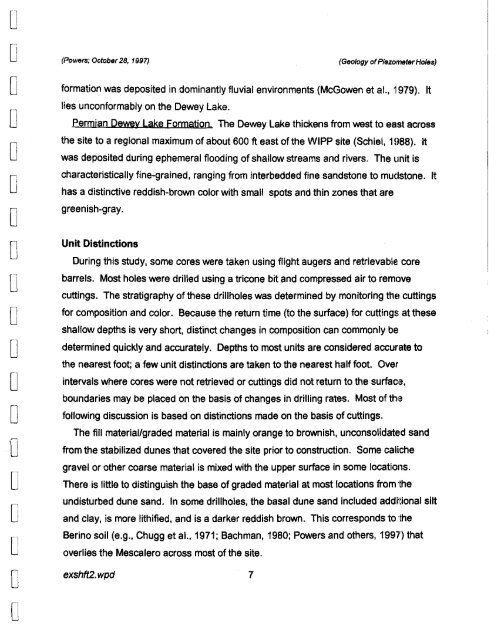o - Waste Isolation Pilot Plant
o - Waste Isolation Pilot Plant
o - Waste Isolation Pilot Plant
You also want an ePaper? Increase the reach of your titles
YUMPU automatically turns print PDFs into web optimized ePapers that Google loves.
u<br />
o<br />
o<br />
o<br />
o<br />
o<br />
o<br />
o<br />
o<br />
o<br />
u<br />
o<br />
o<br />
o<br />
o<br />
o<br />
o<br />
o<br />
o<br />
(Powers; October 28, 1997)<br />
(Geology ofPiezometerHoles)<br />
formation was deposited in dominantly fluvial environments (McGowen et aI., 1979). It<br />
lies unconformably on the Dewey Lake.<br />
Permian DeweY Lake Formation, The Dewey Lake thickens from west to east across<br />
the site to a regional maximum of about 600 ft east of the WIPP site (Schiel. 1HBB). It<br />
was deposited during ephemeral flooding of shallow streams and rivers. The unit is<br />
characteristically fine-grained, ranging from interbedded fine sandstone to mudstone. It<br />
has a distinctive reddish-brown color with small spots and thin zones that are<br />
greenish-gray.<br />
Unit Distinctions<br />
During this study, some cores were taken using flight augers and retrievable core<br />
barrels. Most holes were drilled using a tricone bit and compressed air to rem()ve<br />
cuttings. The stratigraphy of these drillholes was determined by monitoring thE! cuttings<br />
for composition and color. Because the return time (to the surface) for cuttings at these<br />
shallow depths is very short, distinct changes in composition can commonly be<br />
determined quickly and accurately. Depths to most units are considered accurate to<br />
the nearest foot; a few unit distinctions are taken to the nearest half foot. Over<br />
intervals where cores were not retrieved or cuttings did not return to the surfacl~,<br />
boundaries may be placed on the basis of changes in drilling rates. Most of thl~<br />
following discussion is based on distinctions made on the basis of cuttings.<br />
The fill materiallgraded material is mainly orange to brownish, unconsolidatEld sand<br />
from the stabilized dunes that covered the site prior to construction. Some caliche<br />
gravel or other coarse material is mixed with the upper surface in some locations.<br />
There is little to distinguish the base of graded material at most locations tram 'the<br />
undisturbed dune sand. In some drillholes, the basal dune sand included additional silt<br />
and clay, is more Iithifled. and is a darker reddish brown. This corresponds to 'the<br />
Berino soil (e.g., Chugg et aI., 1971; Bachman, 1980; Powers and others, 1997) that<br />
overlies the Mescalero across most of the site.<br />
exshft2. wpd 7

















